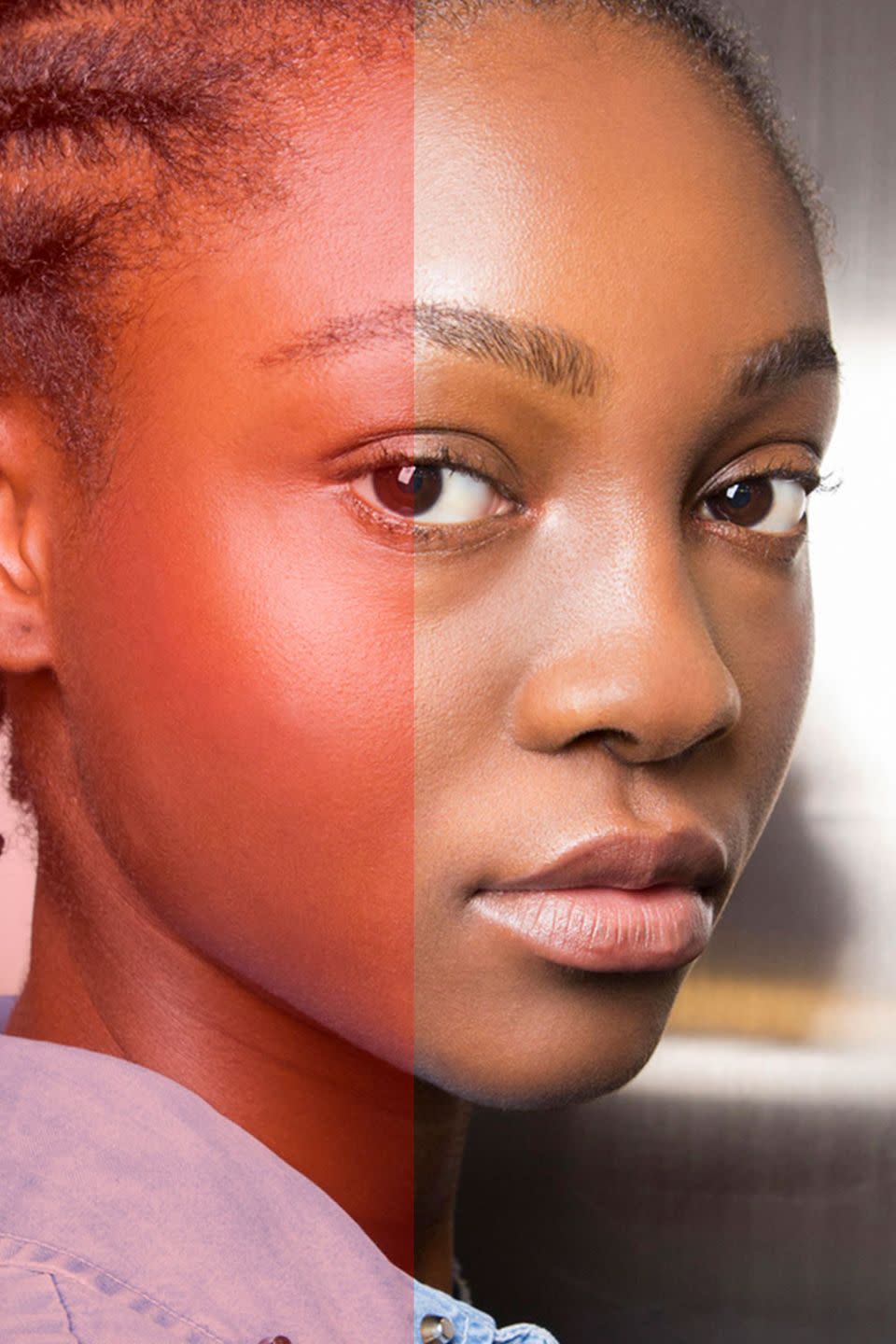Sooo You Effed With Your Face—AGAIN. Here’s How to Fix It

You’re at home, you’re bored, and you’re probably breaking out. Seems like an excellent time to completely and radically alter your skincare routine! Yeah! Go through your medicine cabinet and slather on that weird, definitely expired cream your aunt gave you two years ago! Nice! Finally start that intense retinol that destroyed your skin last time, but who cares now?! Not you! And those scary peel pads?! Hell, yeah! Load ’em up! The world is burning, baby—why not your face too?
Cool. Sooo in hindsight, maybe doing All Of The Things was not the best of moves, yeah? Best intentions, I know, so I’m not here to judge. I’m here to help you, now that your face is broken out/bleeding/stinging/peeling/utterly pissed off. First, stop panicking—you’ll be fine. Provided you just went a little overboard on squeezing or slathering, I’ve gotchu covered with exactly what you need to do and use to calm that ish down ASAP.
THE PROBLEM
❌ You went crazy on acids/treatments and burned your skin
It’s happened to the best of us: You see a zit or some dull skin, so you use a salicylic acid toner. And then a lactic acid serum. And then maybe a swipe of a peel pad. And then a spot treatment. And then you wake up with red, raw, burning skin and a lifetime of regrets. “Acids break down and dissolve the skin cells in your skin barrier, which is good, until you use too much and literally burn off and erode the top layer of your skin,” says Mona Gohara, MD, associate clinical professor at Yale School of Medicine.

THE FIX
Immediately stop using anything harsh. Seriously. Your routine will now be just a gentle cleanser, a thick moisturizer, and—get ready for it—Vaseline. “Vaseline is fantastic in this situation,” says Dr. Gohara. “Whenever doctors do surgeries or biopsies, we often put Vaseline on the wound to create a protective barrier that helps rebuild and heal the skin.” Also, forget what you’ve heard about Vaseline clogging pores—it doesn’t, and multiple studies have proven it.
So every morning and night, slather on a gentle, skin-repairing cream, like Avène Cicalfate Restorative Skin Cream (Dr. Gohara swears by it, and I personally love it), that uses zinc and copper to soothe skin and boost collagen production, then apply a thin layer of Vaseline on top of the irritated, burned parts. And then…be patient. “Your skin takes about 28 days to regenerate, so healing will be a process,” says Dr. Gohara. I know, I know, but don’t freak out—it’s one month. So for at least 28 days, be gentle, lay off the harsh stuff, and let your skin repair itself.
THE PROBLEM
❌ You loaded on the retinol and your skin is peeling off
K, so a little flaking is to be expected with retinol, but if your face is basically falling off, you either went too hard too fast or you used a retinol way too strong for your skin. “Retinoids work by stimulating your collagen production to create newer, fresher skin while also speeding up how quickly your current skin cells shed,” says Dr. Gohara.
For wrinkles, dark spots, scars, and acne, this shedding process is usually excellent—retinol sloughs off your old, discolored skin and churns out smooth, pristine skin. But when you use too much or a too-high dose, “the shedding surpasses the growth and you’re left with flakes and irritation,” she says.

THE FIX
Don’t pick, peel, or scrub off the flakes—which, lemme guess, you’ve already tried. Not only is it pointless (more flakes will just appear in their place), but it’s also risky (peeling off fresh skin can lead to scarring). Instead, your BFF here will be intense hydration. “This is a good time to slap on your hyaluronic acid serum, then a sheet mask on top of it and let it all sit for 20 minutes to really moisturize your skin,” says Dr. Gohara.
Usually, by the time you take off the mask, there won’t any visible flakes, says Dr. Gohara, adding that “they’ll be back, don’t get me wrong, but it will at least give you a reprieve and make applying makeup easier.” Just make sure to apply a gentle, hydrating moisturizer twice a day (like SkinCeuticals Triple Lipid Restore or CeraVe Moisturizing Cream).
The flakes should be gone within a few days, but lay off your retinol for at least five to seven days to make sure your skin is fully healed. Then reintroduce your retinol slowly (the key to avoiding irritation, breakouts, flakes, etc.): Apply it one night a week for one week, two nights a week for two weeks, three nights a week for three weeks, then every other night indefinitely.
THE PROBLEM
❌ You hard-core picked every bump on your face
Ugh, this is me, and ugh, it NEVER GOES WELL. Why do we do this?! Why?! Being stuck at home while also breaking out is a guaranteed recipe for terrible skin decisions. And now, you’re left with swollen bumps, bleeding zits, and oozing patches. Nice. Great. Amazing.
THE FIX
Time, patience, and keeping your freaking hands off your face to let your skin heal. If you just stepped away from the mirror in horror, do damage control ASAP. Wash your hands (soap and water), then cleanse your face with a gentle, hydrating face wash. “Your goal here is to not disrupt things more, which means don’t use any foaming face washes, harsh toners, acne treatments, or scrubs,” says Dr. Gohara.
If you have any bumps that are now oozing or bleeding, stick pimple patches over the wounds (yes, they’re officially wounds) for at least eight to nine hours—or, ideally, overnight—to help the skin heal and reduce the chance of scarring. Then slather on your moisturizer and don’t look in the mirror for the rest of the day.
If you squeezed a cystic zit—you know, the underground pimples that literally cannot be squeezed—and are now left with an inflamed, throbbing giant bump, you need to decrease inflammation fast. Wrap a paper towel around an ice cube, hold it to your zit off and on for 10 minutes, then “dab on 1 percent hydrocortisone cream to help decrease inflammation and swelling,” says Dr. Gohara. Then hands off until…forever.
THE PROBLEM
❌ You used ALL OF THE PRODUCTS and now you’re breaking out
This one feels extra mean. Because, like, you tried. You tried to do right by your skin by finally sticking to a twice-daily skincare routine, and then you wake up covered in bumps. But hold up—that breakout may not actually be acne.
“Using a bunch of new products and sheet masks all at once can trigger perioral dermatitis, or POD, which is basically if acne and eczema had a baby,” says Dr. Gohara. “The chemical irritants trigger a reaction, almost like an inflammatory response in your skin around your mouth, eyes, and/or nose.” The reaction doesn’t look like your classic whitehead/blackhead situation though—“it’s more like a bunch of little red, slightly itchy bumps that aren’t quite poppable and all look the same,” she says.

THE FIX
So under normal circumstances, when we’re not stuck at home, I would say the only fix is to see a dermatologist. Why? Because “POD can look like a lot of things, making it really hard to self-diagnose,” says Dr. Gohara. And the issue here is that using the wrong products—even something as innocent as a spot treatment—could make POD way, way worse.
“Your safest bet is to see a dermatologist virtually, since you don’t want to accidentally stoke the fire on your own,” says Dr. Gohara. But—but!—if you don’t have insurance or can’t afford a visit right now and you’re okay playing a little game of risk, try dabbing a benzoyl peroxide spot treatment over half of the bumps every night for a few days. If they start go fade, great! You are likely working with acne and can continue using benzoyl peroxide on the breakout. Buuut if they grow more inflamed and spread? Get thee to a dermatologist (virtually), who can prescribe a topical antibiotic to clear up the POD.
You Might Also Like


